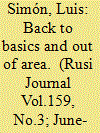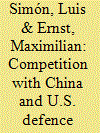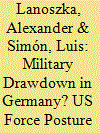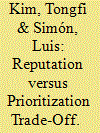|
|
|
Sort Order |
|
|
|
Items / Page
|
|
|
|
|
|
|
| Srl | Item |
| 1 |
ID:
132083


|
|
|
|
|
| Publication |
2014.
|
| Summary/Abstract |
As Allied combat forces return from Afghanistan, Russia's annexation of Crimea has reminded NATO that the security of a rules-based international system in Europe cannot be taken for granted. Efforts to reassure Allies and partners in Eastern Europe have thus become a top priority. This, however, should not lead the Allies to turn their backs on broader, global geostrategic developments - particularly at a time when Asia is emerging as the world's economic and geopolitical centre of gravity. If the West is to prosper in a changing world, argues Luis Simón, it should be able to both defend Europe and project security globally.
|
|
|
|
|
|
|
|
|
|
|
|
|
|
|
|
| 2 |
ID:
192603


|
|
|
|
|
| Summary/Abstract |
What does the decision to designate China as a “long-term strategic competitor” imply for U.S. defence strategy? To address this question, we draw on net assessment and competitive strategies, two complementary frameworks developed in the U.S. Department of Defense (DoD) during the Cold War to understand and manage long-term competition with the Soviet Union, respectively. Net assessment and competitive strategies are tailored around specific competitors and follow a characteristically dialectical approach to strategic planning, based on complex, recursive calculations of move and countermove. We argue that the identification of China as a long-term strategic competitor has paved the way for an increasingly systematic application of net assessment and competitive strategies within DoD, even if obstacles to such application still remain.
|
|
|
|
|
|
|
|
|
|
|
|
|
|
|
|
| 3 |
ID:
184248


|
|
|
|
|
| Summary/Abstract |
There is an intense debate in international relations scholarship on whether the benefits accrued by arms production globalization outweigh the risks of depending on foreign suppliers. Europe is an interesting case: although regional protection could help Europeans mitigate exposure to global actors, the prospect of regional integration generates concerns about autonomy within Europe itself. We depict European defense cooperation as a “two-level playing field,” whereby market size informs a country’s hedging between global-external and European-internal competitors. First tiers push for defense market integration because they expect to be strengthened vis-à-vis global players but also because market size gives them a competitive advantage over fellow Europeans. Second tiers resist market integration, as they worry it might lead to first-tier dominance. To probe our hypotheses, we examine the behavior of two first tiers (France and Germany) and two second tiers (Poland and Sweden) in the context of the European Defense Fund.
|
|
|
|
|
|
|
|
|
|
|
|
|
|
|
|
| 4 |
ID:
177887


|
|
|
|
|
| Summary/Abstract |
The Biden administration has promised to revitalize a transatlantic alliance that has experienced much strain during Donald Trump’s presidency. Trump’s focus on strategic competition with China, equivocal attitude toward Russia, repeated criticisms of NATO and Germany, and insistence that Europeans pay for their own defense have raised questions about the future of US defense strategy in Europe. Nevertheless, his administration in fact committed additional money and troops to deterring Russia from threatening US allies.1 Amid such confusing signals, one of Trump’s last acts that roiled transatlantic relations was to announce in July 2020 a plan to reduce military personnel stationed in Germany from about 34,500 to 25,000, return some portion of these troops to the United States, regroup some air and command assets in Italy and Belgium, and reinforce the US military’s rotational presence in Poland and the Black Sea region. The announcement of these measures stunned European allies, who had not been previously consulted.
|
|
|
|
|
|
|
|
|
|
|
|
|
|
|
|
| 5 |
ID:
154841


|
|
|
|
|
| Summary/Abstract |
The global proliferation of precision-strike systems may be challenging the foundations of Western military-technological supremacy. Relatedly, the development of so-called Anti-Access and Area Denial (A2/AD) capabilities across the globe threatens to complicate Western freedom of military movement and access, and could give way to a more contested military-strategic environment. The twin challenges of precision-strike proliferation and A2/AD strongly impact NATO’s agenda, which revolves around strengthening deterrence and defence in Eastern Europe, and addressing the different threats emanating from the so-called Southern European neighbourhood. In order to address or mitigate such challenges, the Alliance needs to produce operational concepts and capabilities able to deliver deterrence and expeditionary warfare in a maturing precision-strike environment, one characterised by the emergence of A2/AD capabilities.
|
|
|
|
|
|
|
|
|
|
|
|
|
|
|
|
| 6 |
ID:
184244


|
|
|
|
|
| Summary/Abstract |
Under what circumstances is a protégé likely to perceive its patron’s extended deterrence commitments in another region as positive or negative for its own security? Protégés from distant regions see complementary reputational links between the credibility of a patron’s extended deterrence commitments in each other’s region. However, they are in a competitive relationship when it comes to the allocation of the patron’s resources. We call this the reputation versus prioritization trade-off. We argue that whether protégés assign more importance to their patron’s reputation or to being prioritized by said patron is a function of their dynamic perceptions of their regional security environment. These are, in turn, determined by their perception of their patron’s resource constraints and the threat posed by an adversary. To test our argument, we examine how Japan has perceived America’s evolving security commitment in Europe and how Poland has perceived the evolving US commitment in Asia.
|
|
|
|
|
|
|
|
|
|
|
|
|
|
|
|
| 7 |
ID:
145417


|
|
|
|
|
| Summary/Abstract |
The winding down of military operations in Iraq and Afghanistan has prompted a scholarly debate around America’s evolving strategic role and posture in the broader Middle East. Allegedly, its isolated geographical position and “seapower” condition would allow the US to behave as an “offshore balancer”, by pulling back militarily, retreating from alliances and formal security commitments and relying on the different regional powers to balance each other. However, it remains unclear to what extent a seapower like the US would be able to effectively manipulate the balance of power in the Middle East from offshore. An examination of US strategy in the Middle East from 2009 to 2015 suggests that the main puzzle Washington confronts is not so much whether to retreat offshore or remain engaged onshore, but rather to work out the terms of onshore engagement. As this article shows, current US strategy in the Middle East revolves around the need to reconcile two seemingly contradictory sets of pressures. The first is that war fatigue, financial pressures and the ongoing reorientation of military-strategic resources towards the Asia-Pacific theatre do require that the US cuts back on its engagement elsewhere, including in the Middle East. The second relates to Washington’s deep-seated conviction that there is a direct correlation between US forward presence and the preservation of a favourable balance of power in the Middle East, which is itself critical to the security of other regions, including the Asia-Pacific. By discussing the relationship between seapower and forward presence, this article places US strategic retrenchment in the Middle East in perspective. In particular, the article transcends the rather vague notion of “balancing” and concentrates on US perceptions about which geographical areas in the Middle East need to be balanced, and how, i.e., through which alliances, instruments and policies.
|
|
|
|
|
|
|
|
|
|
|
|
|
|
|
|
| 8 |
ID:
146235


|
|
|
|
|
| Summary/Abstract |
Over the last two decades, a number of countries (most notably China, Russia and Iran) have been developing so-called anti-access and area denial (A2/AD) capabilities, such as ballistic and cruise missiles, offensive cyber-weapons, electronic warfare, etc. The development of A2/AD capabilities by non-Western countries undermines the foundations of US power projection and global military-technological supremacy. In order to overcome, or at least mitigate, the impending A2/AD challenge, the US Department of Defense (DoD) began to roll out its so-called ‘third’ offset strategy in late 2014. The strategy aims to bring about innovative operational concepts and technologies and spur new doctrinal and organisational debates. This article assesses which of the operational concepts and capabilities informing current US discussions on offset may be relevant in the context of the A2/AD challenges Europeans face on their eastern ‘flank‘ and in their ‘extended southern neighbourhood‘, and which may not. Europeans must grapple with the same conceptual puzzle as the US: how to strike the right balance between defeating A2/AD capabilities and hedging against them, i.e. through alternative strategies that are less dependent on unhindered access and resort to asymmetric forms of warfare. However, they must take into account the geographical features of their eastern flank and extended southern neighbourhood, the level of technological maturity of their challengers, and their own military-technological prowess and political limitations. This suggests a somewhat different approach to offsetting A2/AD than that adopted by the US.
|
|
|
|
|
|
|
|
|
|
|
|
|
|
|
|
|
|
|
|
|